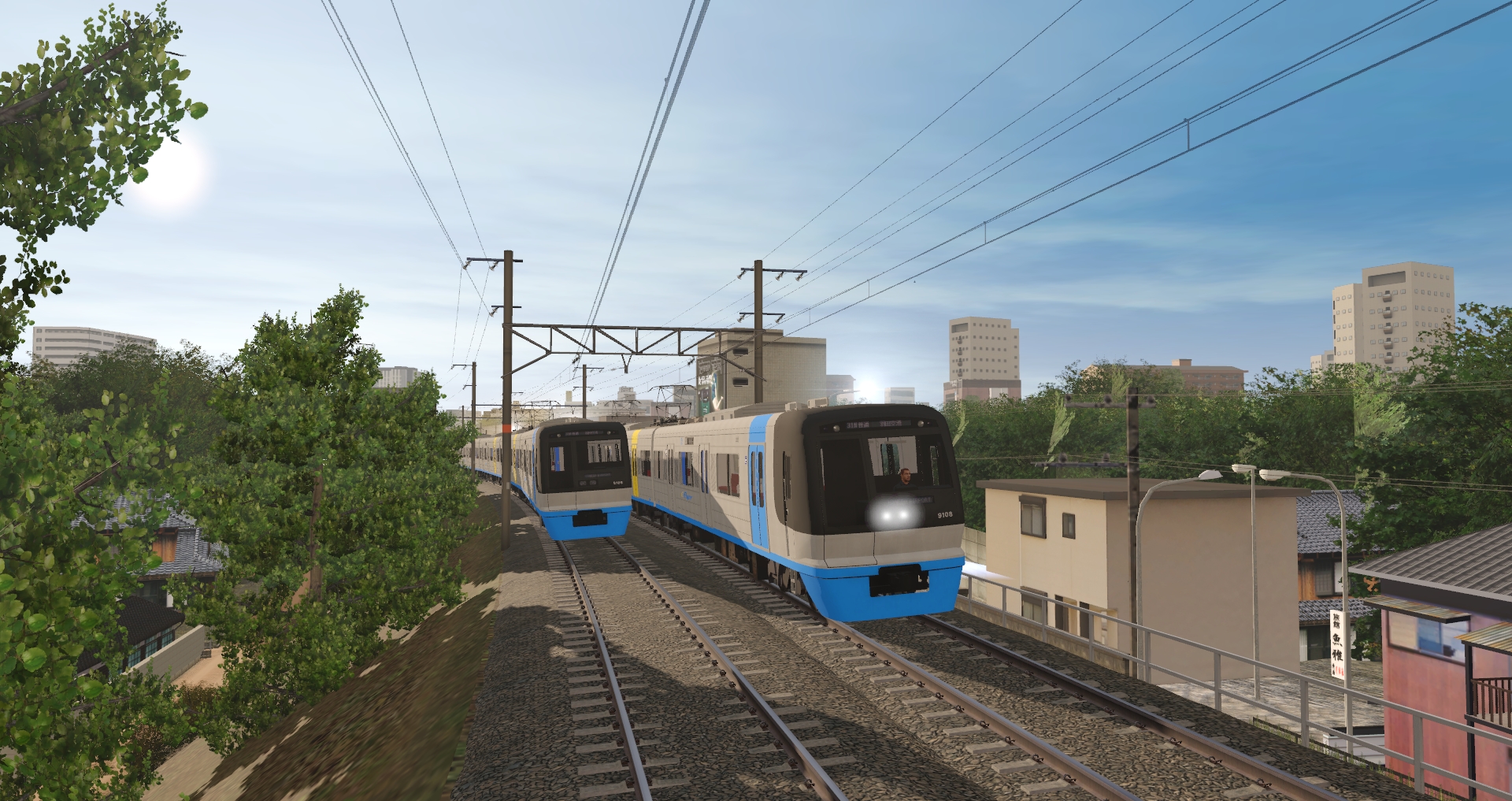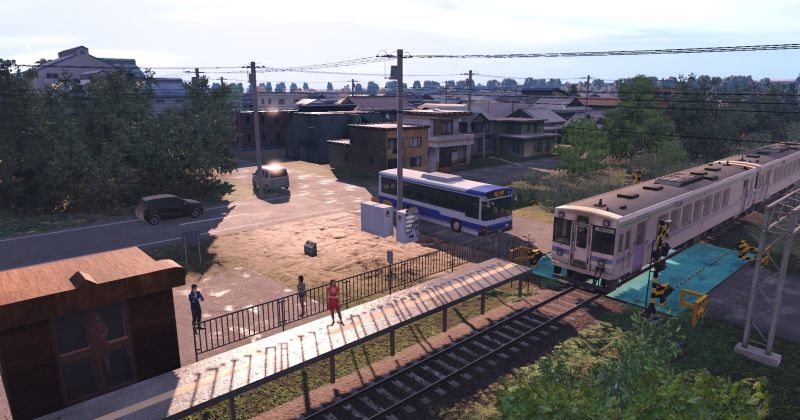Happy new year everyone!
As you may have noticed, this year i unfortunately had to cancel entirely the traditional "Christmas Shinkansen" release, as i had to give priority to univerity-related works, i ended up not having enough time to create the pack in time for the christmas "deadline" - if you're curious, my intended candidate for that pack would've been the 300 Series, the last "major" missing Shinkansen series not yet available for trainz.
For roughly the same reasons, i also had to "rework" my other "traditional" release - the New Year's TRTA train. My intention was for a proper 01 & 02 Series pack, replacing the old ones on my website, but in the end, i opted for a much less variant-intensive pack, and as a break from tradition, this year's won't be a TRTA train either.
With that out of the way, and notwithstanding the 24-hours delay, here's the 2025 New Year's Pack: the funky Housing and Urban Development Pubblic Corporation, Urban Development Pubblic Corporation and Chiba New Town Railway 9100 Series "C-Flyer"!
Already available from my website!
These deliberately odd-looking trains were delivered in 1994 for the then-upcoming 4,7Km-long eastward extension of the Hokuso-Kodan Line from Chiba-Newtown-Chuo to Inzai-Makinohara and were ordered and owned by the same entity owning the infrastructure on wich they were running, and in a sense, the New Town they were intended to serve: the Housing and Urban Development Development Pubblic Corporation.
The HUDC as the pubblic entity responsible for the planning, construction and development of Chiba New Town entered the railway businness in the early 1980s, taking over from Hokuso Railway, a joint-venture of Chiba Prefeture and Keisei Railway, wich at the time was expected to go trough serious financial troubles correlated to the near-crisis of it's parent company Keisei. As such, to ensure that the rest of the line was constructed according to plans and to schedules, HUDC took over the construction of the railway east from it's then-terminus of Komuro, opening to Chiba-Newtown-Chuo in 1984 and in the process, ordering the necessary rolling stock as well - two 2000 Series sets (renamed in 1991 as the 9000 Series to avoid conflicts with trough-running Keikyu stock). Operations (driving, dispatching, maintainance to rolling stock and infrastructure and so on) remained instead assigned to Hokuso Railway, even on the HUDC-built section.
This praxis remained consolidated into the 1990s, even if Hokuso Railway averted financial troubles, and Keisei Railway recovered from it's near-crisis. As such, for the one-station extension to Inzai-Makinohara, HUDC ordered new rolling stock on it's own.
Exceptional care was given to the exterior design of the trains, and for a very specific purpose. As the economic boom slowed down in the early 1990s, less and less people were moving from the country to the city, and cities were growing less and less by the year, contrary to the trend that had been until then, for the past three decades, of constant exponential growth. This created quite an issue for Chiba New Town, whose actual population (and growth prospects) had been falling far short than what had been envisioned, even with the new estimate of 176'000 residents (revised from the original envisioned 340'000 in 1986!).
As such, it now became a question not just to provide housing, but make Chiba New Town attactive to potential new residents, especially considering the over-one-hour commuting distance into Tokyo (e.g. nearly 90 minutes from Chiba-Newtown-Chuo to Shinjuku, via Hokuso-Keisei-Asakusa Line trough-service and Toei Shinjuku Line).
This, aided in the fact that now, rolling stock procurement wasn't such an urgent necessity as it had been before, resulted in HUDC ordering more or less trains deliberately as much "distinctive" as possible, especially in relation to the early-90s mundane style of box-like commuter train.
The base of the design was the de-facto standard: 18m-long bodyshell, stainless steel, three doors per side, a front emergency door (a requirement for subway trough-services, wich these trains were intended to run) and eventually a front cab section made out of FRP (fiber-reinforced plastics) instead of stainless steel.
Within these constraints, the designers were undoubutedly creative: the sides of the bodyshell were made round, rather than vertical flat, the doors fetaured "D"-shaped windows rather than the normal "0"-shaped ones, almost as if they were to form a single window like traditional rolling stock (e.g. Keikyu's 800 Series) and for the front portion, the malleable properties of FRPs were fully taken advantage of to create a smoothly round surface on all sides, inspired by the Azure-tailed Magpie, a common bird within Chiba Prefecture, with the required front emergency door (offset to the right to maximise cab space) and perhaps the most distinctives fetaure of these trains - the twin centrally-located headlight, a fetaure shared with the contemporary Osaka Municipal Subway New 20 Series - and the double front destination indicators, with the top one displaying the train's service number and the destination in japanese, and the lower one, placed centrally above the headlight, but slightly offset, displaying the destination in latin characters (plus english for "Haneda Airport").
The color scheme was also inspired by the Azure-Tailed Magpie, with black surrounding the cab area and light blue being chosen for a thin continuous line on the lower part of the bodyshell and the front skirts at each end.
For the interiors, the same "playing with standards" approach was kept - as these were intended to be subway-trough-service commuter trains, the majority of seating needed to be longitudinal by necessity, however the designers also took care of maximising cross-seating wherever possible, given the afromentioned long distances these trains would be running daily. Within this system, the two end cars of each trains were fitted with exclusively long-seating, plus a wheelchair space, while the intermediate cars were fitted with long-seating between the three door paris, but with cross seating at both ends of the car, with one end being fitted with face-to-face seating, and the other face-to-back seating (in both cases, 8 places per car end).
This was also reflected in the external livery of the train, with the front door of the cab cars, the nearest one to the wheelchair space, being painted in the same light blue as the rest of the livery, and with an additional band visually "prolonging" the door all the way to the roof, while on the intermediate cars, the door adjactent to the face-to-face cross-seating was painted yellow. It's notable that as the trains's arrangment goes, the yellow band is always on the side towards the nearest end of the train, in a sense "pointing" to it - this creates a divide between car 4 and 5, with the two halves of the train pointing in opposite directions.
While the design was deliberately made as distinctive (and in a sense - bespoke) as possible, as HUDC's rolling stock was maintained by Hokuso and Keisei Railway, the company decided to adopt the same equipment as both companie's new rolling stock - Keisei's 3700 Series and Hokuso's direct derivative, the 7300 Series. As such, HUDC's new trains share almost the entirety of their equipment with Keisei's 3700 Series, including but not limited to the bogeys, traction motors, axuiliary equipments (compressors, low-voltage batteries), air-conditioning units and traction control, these being Toyo-Denki-made GTO-VVVF inverters.
Classified "9100 Series" as the successor's to HUDC's 9000 Series, two trains formed as eight-car sets were built by Nippon Sharyo in 1994, and delivered to HUDC within the same year, entering service after the necessary testing, with the opening of the extension to Inzai-Makinohara on the 1st of April 1995, sharing the same assignments as their predecessors: services from the newly-opened terminus trough the whole Hokuso-Kodan Line, then onto the Keisei network at Aoto, then trough the whole Toei Asakusa Line, from Oshiage to Sengakuji and then either onto Keikyu's network, typically to Haneda Airport, or further south on Keikyu's Main Line or instead towards the "Magome Branch" of the Asakusa Line, up to Nishi-Magome.
The new 9100 Series trains were also immediately christened "C-Flyer" upon their entrance in service, with "C" standing obviously for "Chiba", but also for "Comfortable", "Clean" and "Culture" and the "-Flyer" part denoting the intended purpose of these trains - swiftly and quickly carrying commuters into the city and back out as a sort of "first class"-like express service.
By the late 90s however, with the ongoing considerable shift from the economic-miracle and later bubble-era perspective of maximising housing construction and massive new developments, HUDC saw those very two main purposes, it's vocation and reasons for wich it was formed in the first place, becoming less and less relevant. As such, within the context of a broader administrative reform, the Housing and Urban Development Pubblic Corporation was restructured into the simply "Urban Development Pubblic Corporation" on the 30th of September 1999, with the focus now being explicitly less on building housing, but rather development of urban areas as a whole. With this restructuration, the whole Hokuso-Kodan Line and HUDC's former fleet of two 9000 and two brand-new 9100 Series sets were transferred to the new UDC, shedding their light blue HUDC logos for the "post-modernist"-style purple UDC one.
[continues in following post]








